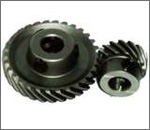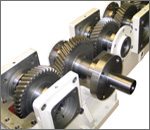Introduction: Whether required to pace the movement of a precision watch or a giant wind turbine, gears play an essential role in the performance of the products that we rely on in our everyday lives. Gears fall into two general categories: motion-carrying and power transmission. Motion-carrying gears are generally nonferrous or non-metals such as plastic while load bearing power transmission gears are usually manufactured from ferrous alloys.
 Alloys and casting process:
Zinc:
Alloys and casting process:
Zinc: Diecasting is generally the most practical and economical method for the high volume production of small spur, worm, rack, level, and helical gears to be used in power transmission trains with light to moderate loading. Almost 50% of all metal gears in small diameters are diecast from zinc alloys. Gears can be diecast within close tolerances resulting in better control of tooth profile.The focus of this article will be on heat treatment of gears intended for heavy duty service applications.
Aluminum: This is the second most widely used metal, which magnesium and brass account only for a small percentage of the market. Ferrous metals are not used commercially for die cast gears.
Die Casting: This process offers a number of advantages for the production of non-ferrous gears. Die cast gears are produced by either the hot-chamber or cold-chamber die casting techniques. First, die cast gears often can be used essentially as-cast. However, various secondary operations can be performed if extra precision or special features are required. Second, virtually any type of gear--spur, bevel, helical, worm, spiral, cluster or shrouded--can be economically die cast. Third, auxiliary features such as cams, ratchets, studs, shafts, retaining ring and lugs also can be cast- in. Finally extremely high production rates are possible. About 75% of die cast gears are currently made of zinc.
Permanent Mold Casting: uses metal as a mold and requires a set-up time of weeks. Typically, cast iron is used as the mold material and the cores are made from metal or sand. Cavity surfaces are coated with a thin layer of heat resistant material such as clay or sodium silicate. The molds are pre-heated up to 200°C before the metal is poured into the cavity. When cooling the mold, care has to be taken to ensure proper thermal balance, by using external water cooling or appropriate radiation techniques. Steel cavities are coated with a refractory wash of acetylene soot before processing to allow easy removal of the workpiece and promote longer tool life.
 Application:
Application: Gears are used almost all kine of products like automobiles, truck transmissions, etc. The gears are made using metals like aluminum cast iron, magnesium aluminum, zinc, etc.
Qualitie:
- Reduced weight
- Lower noise emissions
- High tooth strenght
- Wear resistance
- High running fatigue value.


